Cast iron Dutch ovens heat well due to their impressive thermal properties and heavy construction. You'll find that their high density and thick walls create substantial thermal mass, allowing them to maintain steady temperatures even when you add cold ingredients. Their moderate thermal conductivity (4.9 to 8.4 W/m-K) guarantees heat spreads evenly throughout the pot, eliminating hot spots for consistent cooking results. When properly seasoned, the surface texture enhances heat distribution even further, while the tight-fitting lid effectively circulates steam and heat. The combination of these features makes cast iron Dutch ovens exceptional at everything from searing to slow-cooking, with plenty more benefits to discover.
Cast Iron's Thermal Characteristics
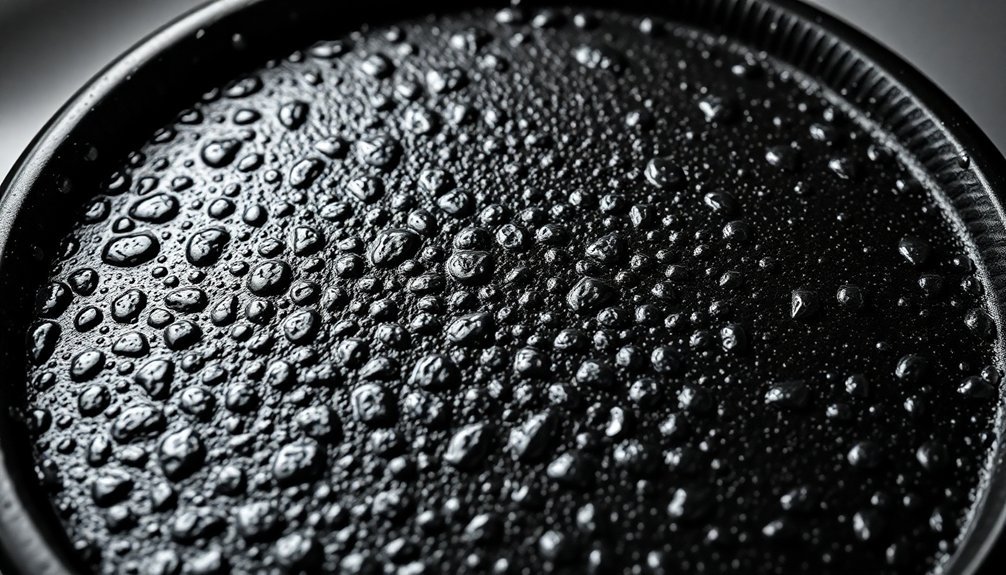
Cast iron's thermal properties make it a powerhouse in the kitchen. When you're cooking with a cast iron Dutch oven, you'll benefit from its moderate thermal conductivity of 4.9 to 8.4 W/m-K, which efficiently transfers heat from your stovetop to your food. This makes cast iron particularly effective for slow heat distribution.
While it's not as conductive as aluminum or copper, this actually works in your favor. Your Dutch oven's high heat capacity and density create substantial thermal mass, allowing it to maintain steady temperatures even when you add cold ingredients.
You won't have to worry about sudden temperature drops, making it perfect for searing meat and slow cooking. The material's impressive melting point of 2,150 to 2,360 degrees Fahrenheit guarantees your Dutch oven can handle intense heat without compromising its structure.
Heat Distribution and Retention Properties
The substantial thermal mass of your cast iron Dutch oven lets you maintain steady cooking temperatures with minimal fluctuations.
You'll notice the thick walls and heavy construction create remarkably even heat zones throughout the entire vessel, from bottom to sides.
This consistent heat distribution eliminates hot spots and guarantees your food cooks uniformly, whether you're searing meat on the stovetop or slow-cooking stews in the oven. The pot's tight-fitting lid plays a crucial role in circulating steam and heat for optimal cooking results.
Thermal Mass Benefits
Superior heat retention stands as a defining characteristic of cast iron dutch ovens, thanks to their remarkable thermal mass properties.
You'll find that these pots absorb heat slowly and store it efficiently due to their high density, allowing you to cook at lower temperatures while maintaining consistent results.
Once your dutch oven reaches the desired temperature, it'll hold that heat steadily, releasing it gradually throughout the cooking process.
This means you won't have to worry about temperature fluctuations that can lead to uneven cooking or burned spots in your food.
The pot's ability to retain heat also makes it incredibly energy-efficient – you'll use less fuel to maintain cooking temperatures, and your food will continue cooking even after you've reduced or turned off the heat source.
The thick-walled construction enables exceptional heat distribution, ensuring every part of your dish cooks at the same rate.
Even Heat Zones
Masterful heat distribution defines Dutch oven cooking, where thick walls and heavy construction work together to create perfectly uniform heating zones.
You'll find that heat spreads evenly throughout the entire pot, from bottom to sides to lid, eliminating problematic hot spots that can ruin your dishes.
When you place your Dutch oven over heat, the cast iron's high thermal conductivity guarantees efficient heat transfer through conduction.
The pot's design creates a dual heating system: conduction moves heat directly through the metal, while convection currents circulate hot air and steam inside.
The tight-fitting lid enhances this effect by trapping moisture and heat, creating a consistent cooking environment.
This combination means you'll get reliable, even cooking temperatures that maintain steady heat zones throughout your cooking process.
Material Density Benefits
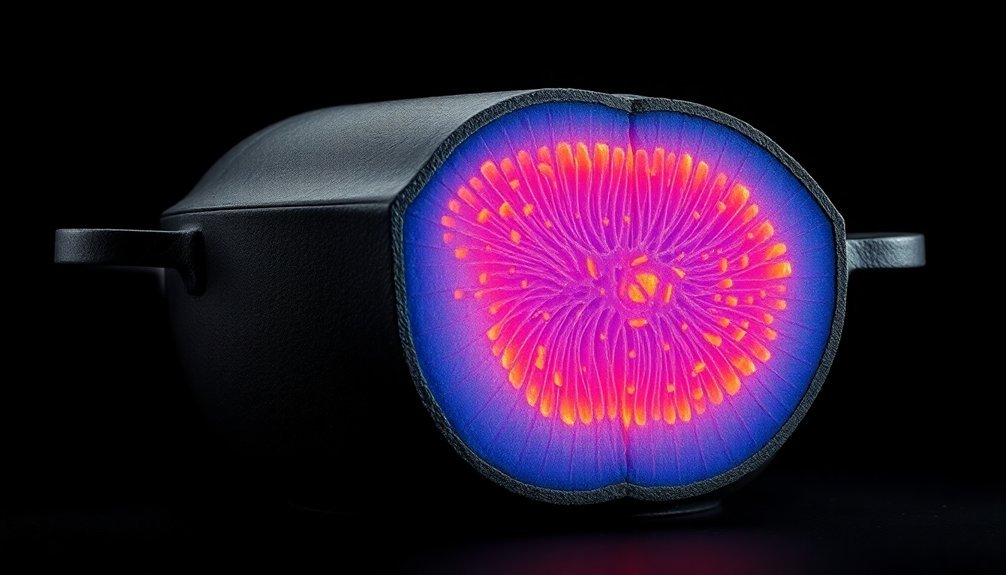
Your cast iron Dutch oven's remarkable density offers significant thermal mass advantages, letting you maintain steady cooking temperatures for extended periods.
You'll notice this density enables exceptional heat storage capabilities, as the pot absorbs and retains heat more effectively than lighter cookware materials.
The high thermal mass also gives you improved temperature control, preventing sudden temperature fluctuations that could affect your cooking results.
Thermal Mass Advantage
The mighty density of cast iron creates a thermal powerhouse in your Dutch oven. You'll find that it absorbs and stores more heat than other cookware materials, maintaining consistent cooking temperatures throughout your meal preparation. This exceptional heat storage means you can cook at lower temperatures while achieving better results.
| Material | Heat Storage | Recovery Time |
|---|---|---|
| Cast Iron | Highest | Slow |
| Stainless Steel | Moderate | Moderate |
| Aluminum | Low | Quick |
| Copper | Low | Quick |
| Granite Ware | Lowest | Very Quick |
Your cast iron Dutch oven's thickness and weight contribute directly to its thermal mass advantage. While it'll take longer to heat up initially, you'll benefit from superior temperature regulation and even cooking. This high thermal mass prevents sudden temperature changes, making it ideal for long-cooking dishes like stews and braised meats.
Heat Storage Capabilities
Three key material properties make cast iron Dutch ovens exceptional at storing heat.
First, their high density means they pack more mass into a given volume, allowing them to absorb and hold substantial thermal energy.
Second, cast iron's impressive heat capacity lets it store significant amounts of heat before its temperature rises.
Third, the material's thick construction enhances its ability to retain heat for extended periods.
You'll notice these properties working together when you're cooking.
Once your Dutch oven heats up, it'll continue releasing heat steadily, even after you've removed it from the heat source.
This excellent heat storage capability means you can cook at lower temperatures and maintain consistent heat levels, making it ideal for slow cooking, braising, and other techniques that require stable temperatures.
Improved Temperature Control
Building on its impressive heat storage capabilities, cast iron's high material density provides remarkable temperature control that transforms your cooking experience.
The material's impressive density guarantees consistent temperatures throughout your cooking process, while efficiently distributing heat across the entire surface.
You'll find that once your Dutch oven reaches your desired temperature, it maintains that heat level steadily, eliminating hot spots that could burn your food.
This stable temperature control means you can cook at lower heat settings, saving energy while achieving better results.
Whether you're braising, baking, or slow-cooking, you'll get uniform heat from bottom to sides.
For outdoor cooking, you can precisely control temperatures using the charcoal briquette method, which lets you achieve specific temperatures by adjusting the number of briquettes above and below your Dutch oven.
Thick Wall Construction Advantages
When it comes to cast iron Dutch ovens, thick wall construction stands as a cornerstone feature that delivers multiple cooking advantages.
You'll find these heavy-duty pots excel at heat retention and distribution, making them perfect for everything from slow-cooking to braising.
- The high thermal mass of thick walls absorbs and stores heat, releasing it slowly to maintain steady cooking temperatures.
- You'll enjoy uniform heat distribution across the entire surface, preventing hot spots and ensuring even cooking.
- These pots are incredibly energy-efficient, letting you cook at lower temperatures while trapping moisture effectively.
- The robust construction allows for versatile cooking methods, from stovetop searing to oven braising.
With these thick walls working in your favor, you'll achieve consistently tender meats and perfectly cooked dishes every time.
Surface Texture Effects
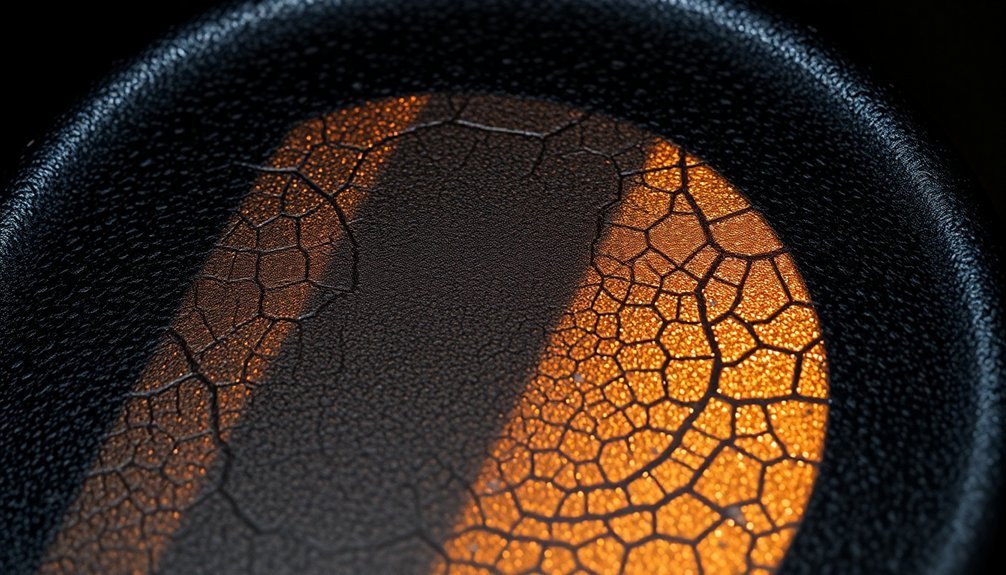
You'll notice significant improvements in your Dutch oven's cooking performance as you build up layers of seasoning, which fills the naturally porous surface and creates a smooth, non-stick coating.
The textured surface of cast iron promotes efficient heat exchange through increased surface area, while properly seasoned surfaces help distribute heat more evenly across your cookware.
As you continue using your Dutch oven, the surface texture will become increasingly refined through repeated seasoning and use, enhancing both its non-stick properties and heat distribution capabilities.
Seasoning's Impact on Cooking
A properly seasoned cast iron Dutch oven transforms your cooking experience through its unique surface properties. The multiple layers of polymerized oil create a smooth, non-stick surface that you'll find essential for preparing delicate foods and achieving consistent results.
As you cook, the seasoning continues to improve, making your Dutch oven more versatile and reliable.
Here's how seasoning enhances your cooking:
- Creates a hydrophobic surface that prevents food from sticking and makes cleanup easier
- Fills in surface irregularities for more even heat distribution and better browning
- Develops a protective layer that prevents rust and extends your pot's lifespan
- Forms a carbonized, non-stick surface that improves with each use, allowing you to cook without excessive oil
Porosity and Heat Exchange
Surface texture plays an essential role in how your cast iron Dutch oven performs during cooking. You'll notice significant differences between enameled and raw cast iron surfaces.
Enameled Dutch ovens feature a smooth, nonporous coating that's easy to clean and doesn't require seasoning. This glass-like surface prevents ingredients from seeping into the pot and protects against chemical reactions with acidic foods.
Raw cast iron, however, has a naturally rough, porous surface that needs regular seasoning to maintain its non-stick properties. When you season your pot, the oil fills these tiny pores and creates a smoother cooking surface.
While both types conduct heat efficiently, their different textures affect how you'll need to care for and cook with them. The enamel's smoothness offers convenience, while raw cast iron's texture requires more maintenance but builds character over time.
Textural Changes Over Time
When your cast iron Dutch oven is new, its surface begins an ongoing transformation through seasoning and use. You'll notice patchy or uneven coloring at first, but don't worry – this is normal.
As you cook and maintain your Dutch oven, the surface develops a smooth, non-stick patina through multiple layers of polymerized oil.
Here's what happens to your Dutch oven's surface over time:
- Initial seasoning creates interlocking protective layers
- Regular cooking builds up additional seasoning, evening out the surface color
- The texture becomes increasingly smooth and glossy with proper maintenance
- A dark, uniform patina develops, indicating well-seasoned cast iron
You can speed up this process by using extra oil while cooking and avoiding harsh cleaning methods that might strip the seasoning.
Remember to re-season after deep cleaning to maintain the non-stick properties.
Seasoning Impact on Performance
The seasoning process fundamentally transforms a cast iron Dutch oven's performance by creating a durable, non-stick surface through polymerized oil layers.
When you properly season your Dutch oven, you'll notice improved cooking efficiency and easier food release, as the polymerized oil fills in the iron's microscopic pores and creates a smooth, hydrophobic surface.
You'll find that a well-seasoned Dutch oven not only prevents rust but also protects your food's flavors by eliminating any metallic taste.
As you continue to use and maintain your Dutch oven, its non-stick properties will keep improving. The seasoning's protective layer becomes more resilient with each use, developing a distinctive black sheen that indicates proper polymerization.
Regular maintenance and careful cleaning will help preserve these enhanced performance benefits.
Thermal Mass Significance
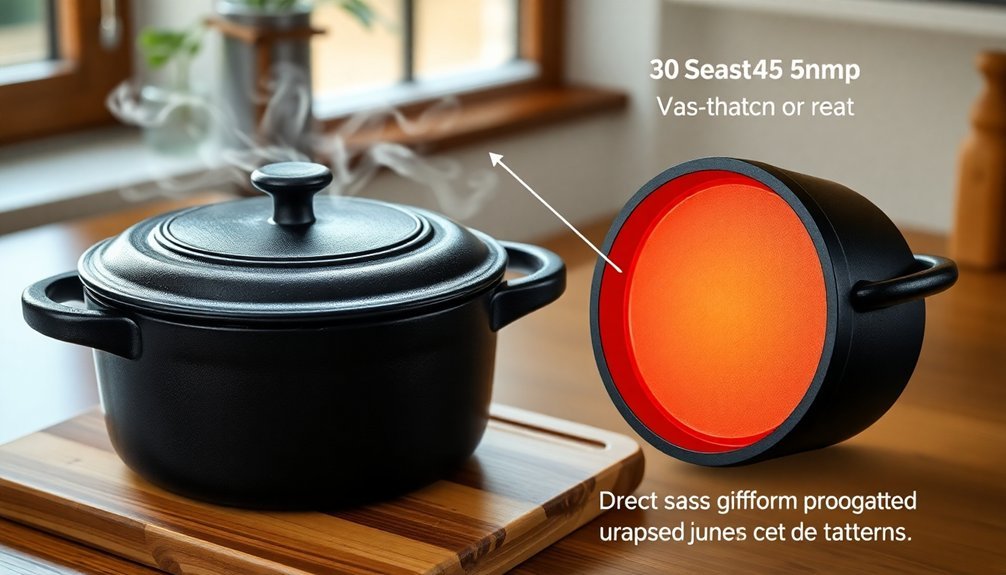
Thanks to its exceptional density and thickness, cast iron's thermal mass plays a pivotal role in Dutch oven cooking performance.
You'll notice that cast iron can store and retain considerably more heat than other cookware materials, which makes it ideal for maintaining consistent cooking temperatures.
- Your cast iron Dutch oven will take longer to heat up and cool down compared to aluminum or stainless steel, giving you more control over temperature changes.
- You'll get superior heat distribution that eliminates hot spots and guarantees even cooking.
- You can expect better searing and browning results due to the pan's ability to maintain high temperatures.
- You'll benefit from stable cooking conditions that minimize temperature fluctuations, perfect for slow-cooking dishes and bread baking.
Heat Transfer Mechanisms
Understanding how heat moves through your cast iron Dutch oven builds on its impressive thermal mass properties.
When you place your Dutch oven on a heat source, conduction immediately transfers heat through the dense cast iron walls and base. You'll find that the pot's thickness guarantees uniform heating throughout.
As your pot heats up, convection takes over inside. The tight-fitting lid creates an environment where heat circulates efficiently, while its dimples collect and return moisture to your food.
While radiation plays a smaller role, it's still present, especially when you're using your Dutch oven in the oven rather than on the stovetop.
Together, these mechanisms work to maintain consistent temperatures. You'll get even cooking results because the cast iron effectively absorbs, stores, and distributes heat through all three processes.
Temperature Control Features

Mastering temperature control in your cast iron Dutch oven relies heavily on proper charcoal management and heat distribution techniques.
You'll need to calculate briquettes based on your oven's diameter and adjust their placement according to your cooking method. When baking, place 1/3 of coals underneath and 2/3 on top; for roasting, distribute them evenly.
- Calculate total briquettes needed by doubling your Dutch oven's diameter
- Arrange coals in a checkerboard pattern for even heat distribution
- Rotate your oven and lid every 15 minutes to prevent hot spots
- Replace spent coals as they turn to ash to maintain consistent temperature
The oven's high thermal mass helps maintain steady temperatures once achieved, making it perfect for slow-cooking methods like braising and stewing.
You can fine-tune control using probe thermometers and quality briquettes like Kingsford.
Solar Energy Absorption Capacity
Beyond traditional heat sources, cast iron Dutch ovens excel at harnessing solar energy through their unique material properties. Their black surface and high thermal mass make them effective at absorbing and storing the sun's rays, while their dense composition helps maintain consistent temperatures throughout the cooking process.
When you're using a cast iron Dutch oven in a solar cooker, you'll find that reflective surfaces and clear covers enhance its performance by concentrating sunlight and trapping heat.
While it may take longer to heat up compared to other materials, once your Dutch oven reaches the desired temperature, it'll maintain that heat steadily. You'll get the best results on sunny days using parabolic solar cookers, which can generate intense heat to overcome cast iron's slower initial heating time.
Weathering and Durability
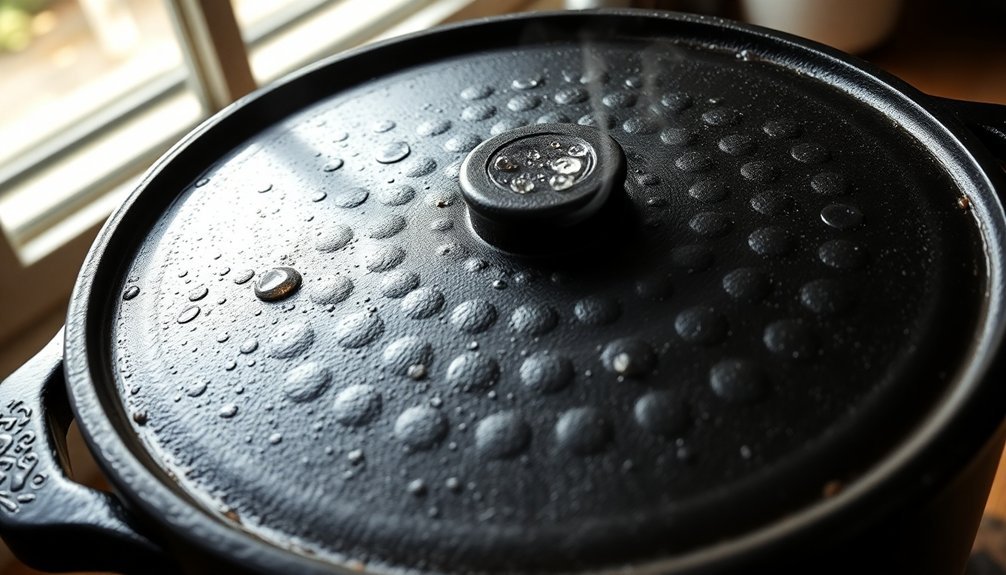
When it comes to durability, cast iron Dutch ovens stand as champions of the kitchen, offering remarkable resilience that can span generations.
Cast iron's high-density structure allows it to withstand intense heat without warping, while effectively absorbing and distributing heat throughout your cooking process.
- Raw cast iron requires regular seasoning to prevent rust, while enameled versions don't need this maintenance.
- You'll find enameled surfaces easier to clean with just hot water and soap.
- The tight-fitting lid creates an ideal environment for slow cooking and bread baking.
- Your Dutch oven's thermal mass guarantees steady temperatures and even heat distribution.
While these pots are incredibly durable, you'll need to watch for potential enamel chipping and avoid sudden temperature changes that could damage the surface.
They're heavy, but that's a small trade-off for their exceptional longevity.
Frequently Asked Questions
Can Cast Iron Dutch Ovens Be Used on Induction Cooktops?
Yes, you can use your cast iron Dutch oven on an induction cooktop. It's completely compatible because of its magnetic properties, and you'll get efficient, even heating. Just remember to lift, not slide, to protect the surface.
How Does Altitude Affect Cooking Times in Cast Iron Dutch Ovens?
At higher altitudes, you'll need longer cooking times due to lower air pressure. You should increase your temperature settings and extend cooking periods by about 25% for every 5,000 feet above sea level.
Why Do Some Recipes Specify Black Versus Enameled Dutch Ovens?
You'll want to use black Dutch ovens for high-heat searing and seasoning-building, while enameled ones are better for acidic foods and liquids since they won't react with your ingredients or need seasoning.
Does the Color of Enameled Dutch Ovens Affect Cooking Performance?
No, your enameled Dutch oven's color won't affect its cooking performance. While lighter interiors help you monitor food better, and darker ones hide wear, the heat retention and distribution remain the same across colors.
Can Dutch Ovens Be Used in Microwave Ovens Safely?
No, you shouldn't put Dutch ovens in microwaves. They're metal, which can cause dangerous sparking and arcing. The metal surface reflects microwaves, preventing proper heating and potentially damaging your microwave or causing fires.
In Summary
Your cast iron Dutch oven heats well due to its dense construction and thick walls that distribute heat evenly. You'll find that its superior heat retention comes from cast iron's high thermal mass and the material's natural ability to maintain steady temperatures. Once you've heated it properly, the pot's seasoned surface helps transfer heat effectively to your food while providing excellent temperature control for your cooking needs.

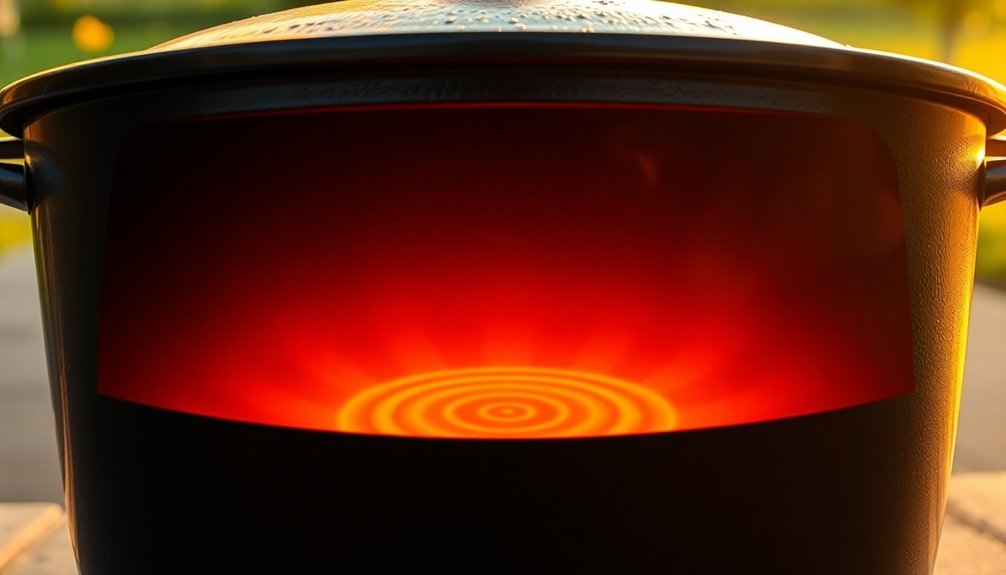
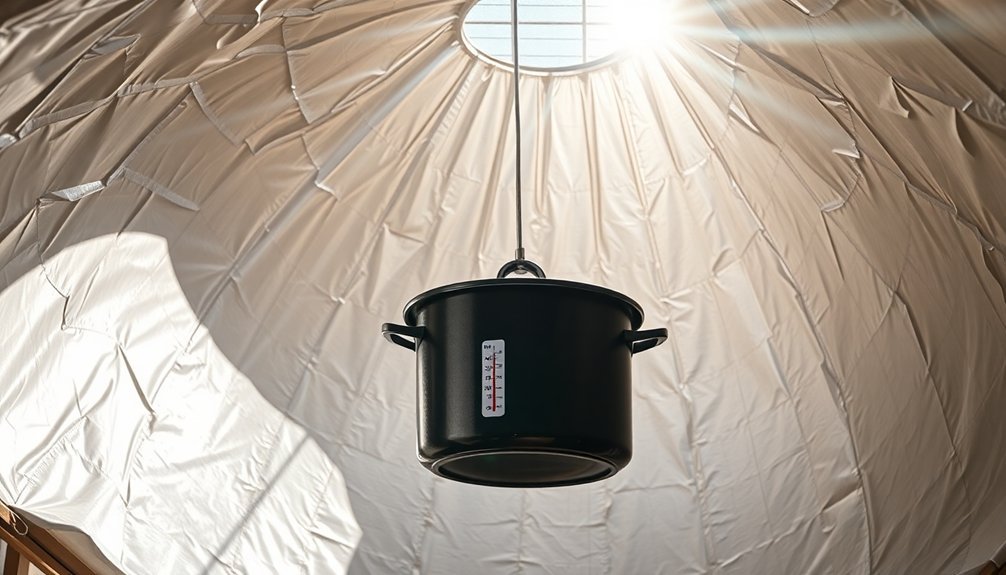

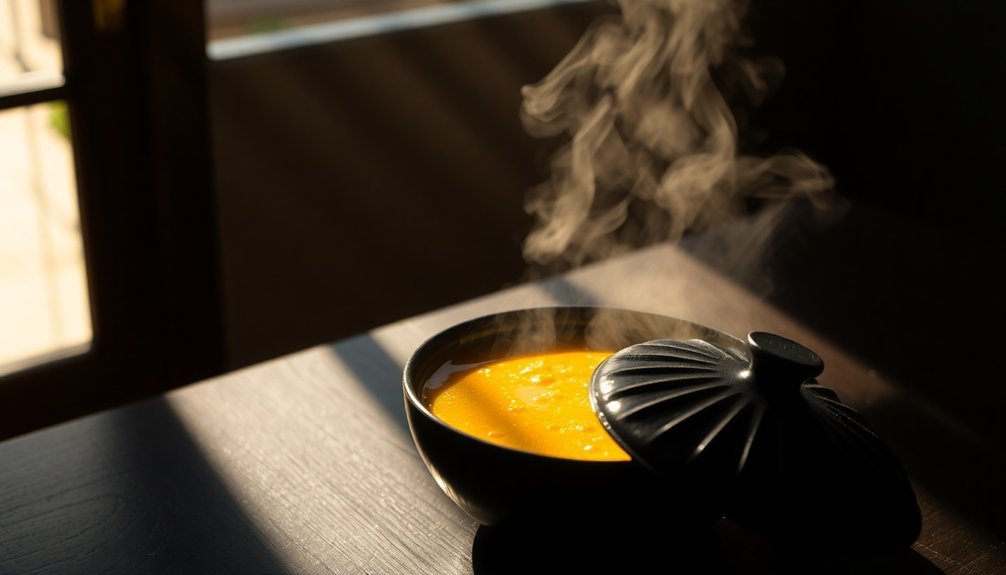
Leave a Reply